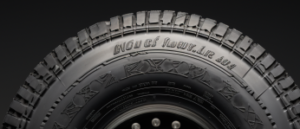Last Updated on April 25, 2024
Understanding the Code: Navigating the World of Truck Tire Safety and Compliance
The Department of Transportation (DOT) number on truck tires is more than just a random collection of letters and digits. It is a unique identifier that provides vital information about the tire’s manufacturing details. Understanding the DOT number is crucial for truck drivers, fleet managers, and safety inspectors to maintain vehicle safety and compliance with regulations.
The DOT number is typically found on the tire’s sidewall and includes a series of characters that indicate the manufacturing location, tire size, and the week and year the tire was made. The United States Department of Transportation standardizes this numbering system, and it is a requirement for all tires sold in the United States for use on public roads.

Importance of DOT Numbers for Truck Tires
The DOT number is crucial throughout a truck tire’s lifespan for multiple reasons.
- Guaranteed Safety: The DOT number is primarily used to ensure safety. Customers and inspectors can use it to confirm that the tire satisfies all DOT safety requirements. These codes also assist in determining which tires require replacement in the event of a recall.
- Monitoring quality: Fleet managers and drivers may monitor the performance and quality of individual tire batches by tracking the manufacturing facility and time. This data can make finding trends in wear, durability, and performance easier.
- Regulatory Compliance: Commercial trucks must comply with federal and state safety regulations. The DOT number proves that the tire has passed all necessary tests and is fit for use on public roads. Failing to use DOT-approved tires can lead to penalties and fines.
- Age Determination: Tires degrade over time, even without use. The DOT number helps determine the tire’s age, which is crucial for managing tire replacement schedules. Using tires beyond their safe operational period can lead to dangerous driving conditions.
- Identification during a Recall: The DOT number enables owners to promptly ascertain whether their tires are impacted in the event of a recall brought on by production flaws or safety concerns. Through timely replacements and accident prevention, this early identification can be ensured.
- Liability and insurance: If tire failure is thought to have contributed to the accident, insurance companies may need DOT numbers to process claims. Using and correctly maintaining tires with current DOT numbers can save businesses from lawsuits.
As part of the comprehensive guide by “Tires Easy Truck,” understanding the significance of DOT numbers helps truck operators make informed decisions about tire maintenance and replacement, enhancing road safety and efficiency.
Understanding the DOT Number
Understanding the DOT number on a truck tire is essential for ensuring the safety and compliance of the vehicle. This introduction unravels this code’s mysteries, exploring its role in the tire industry and its significance for truck drivers and fleet managers. The U.S. Department. Transportation requires that each tire have a DOT number to serve as a unique identification that attests to its compliance with safety regulations and provides vital details regarding its production. The significance of DOT numbers for upholding strict traffic safety regulations and regulatory compliance becomes clear as we go deeper into the realm of DOT numbers.
What is a DOT Number?
In the U.S., a tire’s U.S. wall is stamped with a unique identification number known as a DOT or Department of Transportation number. With this code, you may be sure that the tire meets all safety requirements the U.S. Department of Transportation sets forth. The DOT number, which provides information about the tire’s origin, size, and manufacturing date, is essential to tire identification.
The letters “DOT,” followed by a series of characters, usually start the format of a DOT number. There are two major categories for these characters:
- Manufacturer’s Identification Code: The first part of the DOT number, consisting of two to three letters or numbers, identifies the manufacturing plant where the tire was produced.
- Tire Specifications Code: This section includes information about the tire size and specific characteristics related to its construction.
- Date of Manufacture: The last four digits represent the week and year the tire was manufactured. For example, “3219” would indicate the tire was made in the 32nd week of 2019.
History and Significance
The National Traffic and Motor Vehicle Safety Act of 1966 established the DOT numbering system as part of the Motor Vehicle Safety Standards. This law attempted to decrease accidents brought on by poor vehicle design and construction in response to growing worries about motor vehicle safety. The DOT number is essential because it plays a part in guaranteeing tire quality and safety:
- Standards for Safety Implementation: The Department of Transportation’s performance, durability, and safety tests, for which the tire is required to pass, are certified by the DOT number.
- Efficiency of Recall: The DOT number effectively identifies impacted tires, guaranteeing their prompt removal from operation if a tire recall is required owing to safety concerns.
- Consumer Information: For consumers, the DOT number provides a means to verify the age and origin of the tires they purchase, which is critical for making informed decisions regarding tire safety and performance.
- Historical Data: The introduction of the DOT number has provided a wealth of data for safety analysts and manufacturers, allowing for continual improvement in tire design and manufacturing processes.
- Regulatory Compliance: Manufacturers must adhere to the DOT standards to sell their tires in the U.S. market; the U.S. ensures a baseline level of quality and safety across all tires available to American consumers.
The DOT number is essential in the tire industry, guaranteeing quality and safety. Truck drivers and fleet managers, especially those engaging with “Tires Easy Truck” must understand the DOT number, which is crucial for maintaining high security and compliance standards. This knowledge helps ensure the vehicles are equipped with safe, compliant tires and assists in effective tire management and maintenance practices.
Components of a DOT Number
The DOT (Department of Transportation) number is pivotal in truck tire safety and identification. This unique sequence, found on the sidewall of each tire, is much more than a random set of characters. It provides essential information about the tire’s origin, size, and manufacture date. Understanding each component of the DOT number is crucial for truck operators, as it aids in maintaining compliance with safety regulations and making informed tire selection and maintenance decisions.
Manufacturer’s Identification
The first part of the DOT number is the manufacturer’s identification code. This is a two-to-three-letter or number sequence that identifies the specific factory where the tire was produced. Each tire manufacturing plant has its unique code. This code is crucial for determining the source of the tire, which can be particularly important in the event of a product recall or quality control issue.
Tire Size Code
Following the manufacturer’s identification is the tire size code. This part of the DOT number corresponds to the tire size and is directly linked to the specifications for which the tire was designed. It helps determine whether a particular tire is suitable for a specific vehicle or type of truck. The tire size code is represented by numbers and letters, which provide details such as the tire’s width, aspect ratio, and construction type (radial).
Manufacturer’s Unique Code
The following section is the manufacturer’s unique code. This segment, which may consist of several characters, provides specific information about the tire’s brand and other characteristics determined by the manufacturer. It can include details about the tire’s range, model, or specific technology used in its construction. This code is vital in distinguishing tires within the same size category but with different performance or design features.
Date of Manufacture
The final part of the DOT number is perhaps the most critical for safety – the date of manufacture. This four-digit code indicates the week and year the tire was manufactured. For example, a tire with the code “0521” was made in the fifth week of 2021. Understanding the tire’s age is essential for managing its lifecycle, as tire properties can deteriorate over time, regardless of use. This part of the DOT number helps drivers and fleet managers ensure they are not using tires that are too old and potentially unsafe.
Each component of the DOT number on truck tires serves a distinct and essential purpose. The DOT number is vital in ensuring road safety and regulatory compliance, from identifying the manufacturing plant to understanding the tire’s size, unique features, and age. For users of “Tires Easy Truck,” recognizing these elements is not just about adhering to standards; it’s about ensuring the safety and reliability of their trucks on the road.
Interpreting the DOT Number
In the context of truck tire maintenance and safety, the ability to interpret the Department of Transportation (DOT) number is invaluable. This code, embossed on the sidewall of every truck tire, is a key to unlocking important information about the tire’s manufacture and specifications. Truck operators and fleet managers, particularly those engaged with “Tires Easy Truck,” need to understand how to read this number, as it is crucial for ensuring their vehicles are equipped with safe, appropriate tires that comply with legal standards.
Reading the Manufacturing Week and Year
One of the most critical aspects of the DOT number is the last four digits, which represent the tire’s manufacturing date. This code indicates the week and year the tire was produced. The first two digits specify the week of the year (from 01 to 52), and the last two digits indicate the year. For example, a DOT number ending in “1422” signifies that the tire was manufactured in the 14th week of 2022.
Understanding a tire’s age is crucial as it affects tire performance and safety. Tires degrade over time, and using overly aged tires can increase the risk of tire failure. Therefore, it’s essential for truck operators to regularly check these dates to ensure their tires are within a safe age range.
Deciphering Manufacturer and Plant Code
The initial part of the DOT number, immediately following the “DOT” prefix, is the manufacturer and plant code. This segment usually consists of two to three characters and uniquely identifies the manufacturing facility where the tire was produced. Each manufacturing facility, even those owned by the same company, has a different code.
This information can be essential in recalls or quality control issues. By knowing the specific plant where a tire was made, operators can quickly determine if their tires are part of a defective batch, ensuring timely replacement or inspection.
Understanding Size and Specifications
Following the manufacturer and plant code, the DOT number includes characters related to the tire size and type. This segment of the number details the tire’s dimensions and construction features, which are crucial for determining if a tire is appropriate for a specific truck or trailer.
This part of the DOT number is often a combination of numbers and letters referencing the tire’s width, aspect ratio, and construction type (radial). Correctly interpreting this information ensures that the tires meet the vehicle’s requirements, providing optimal performance and safety.
Interpreting the DOT number is a fundamental skill for anyone responsible for truck maintenance and safety. Each section of this number—the manufacturing date, plant code, and size specifications—provides valuable information that helps make informed decisions about tire maintenance and replacement.

The Role of DOT Numbers in Truck Tires
In addition to being required by law, the Department of Transportation (DOT) number on truck tires plays a critical role in legal compliance and road safety. It is crucial for fleet managers and truck operators, particularly those connected to “Tires Easy Truck,” to comprehend and follow the guidelines established by the DOT number. The legislative requirements for DOT numbers and their function in guaranteeing tire safety are covered in detail in this section.
Legal Requirements for DOT Numbers
The legal mandate for DOT numbers on tires comes from the U.S. Department of Transportation’s mission to ensure safety in motor vehicle operations. All tires sold in the United States for use on public roads must bear a DOT number, which shows that the tire conforms to the safety standards established by the DOT. These standards encompass various aspects of tire construction and performance, including but not limited to tread quality, durability, and resistance to heat and impact.
The DOT number must be printed on at least one tire’s sidewall. This rule guarantees that the tires, primarily commercial trucks, are roadworthy and can be traced back to the manufacturer. Failure to comply with this requirement may result in legal consequences, such as fines and penalties.
The Role of DOT Numbers in Tire Safety
The DOT number plays a critical role in maintaining tire safety in several ways:
- Accountability and Traceability: Tires can be traced back to their manufacturers thanks to their DOT number. This is a critical component in a recall because of safety concerns. It ensures that tires that may be dangerous can be promptly detected and taken out of service to prevent accidents.
- Tire Replacement Age Tracking: The tire’s age can be ascertained by looking up the manufacturing date encoded in the DOT number. Even in periods of non-use, tires can age and degrade. By keeping track of their age, truck drivers can replace worn tires before they pose a safety risk.
- Ensuring Quality and Performance: Compliance with DOT standards, as indicated by the DOT number, reassures users that the tire has undergone rigorous testing and meets specific safety and performance criteria. This assurance is vital for truck drivers who rely on their tires for their own and other road users’ safety.
- Legal and Insurance Implications: In the case of accidents, using DOT-compliant tires can be a significant factor in legal and insurance considerations. Tires need a valid DOT number, or those past their safe usage date can negatively impact insurance claims and lead to legal liabilities.
Practical Tips for Truck Drivers
Comprehending and managing tire safety is essential to truck drivers’ daily operations, especially for those connected to ‘Tires Easy Truck.’ The Department of Transportation (DOT) number on each tire is essential information. Truck drivers can use the helpful advice in this section to guarantee the best possible tire performance and safety based on the data supplied by the DOT number.
Regularly Checking DOT Numbers
Regular inspection of the DOT numbers on truck tires is a crucial practice for maintaining safety. Truck drivers should:
- Find the DOT Number: Each tire’s DOT number is on the sidewall. Typically, it begins with the letter “DOT” and then some characters.
- Examine the text for legibility: Make sure the DOT number is clear and readable. It can indicate that the tire is getting close to the end of its useful life if it is worn out or concealed.
- Note the Numbers: Record the DOT numbers for every tire in a log. This record may be beneficial for tracking tire age and providing easy access to tire recalls or inspections.
Understanding Tire Wear and Age
The DOT number can be instrumental in assessing tire wear and age:
- Determine Tire Age: The last four digits of the DOT number indicate the week and year of manufacture. For example, “2519” means the tire was made in the 25th week of 2019.
- Monitor Tire Aging: Even if a tire appears to have minimal wear, it can still degrade over time. Rubber compounds in tires deteriorate with age, affecting performance and safety.
- Assess Wear Patterns: Regularly check the tire tread and sidewalls for signs of uneven wear, cracks, or other damage. Early detection of these issues can prevent accidents and improve vehicle handling.
When to Replace Tires Based on DOT Information
Using the DOT number to determine the right time to replace tires is a critical safety measure:
- Observe Age Guidelines: Tires six or older should generally be replaced regardless of their visible condition. A tire’s internal strength may deteriorate with age, raising the possibility of failure.
- Keep Up with Recalls: If your tires are subject to a recall, you can find out by looking up the manufacturer’s identifying portion of the DOT number. For information on any recalls, contact the National Highway Traffic Safety Administration or tire manufacturers regularly.
- Consideration for Conditions and Use: The way that tires are used (weight of the load, types of roads, speeds at which you drive), as well as the surrounding environment (temperature, sunlight exposure), can all have an impact on how quickly tires age and wear out.
For those driving with “Tires Easy Truck,” these tips ensure compliance with safety standards and enhance the longevity and reliability of their tires on the road.
Advanced Considerations
For those managing commercial truck fleets, such as those at “Tires Easy Truck,” the DOT (Department of Transportation) number on truck tires is more than a regulatory requirement. It is a crucial component in fleet management strategies and has significant implications for insurance and liability. This section explores how DOT numbers are pivotal in these advanced considerations.
DOT Numbers in Fleet Management
In the realm of fleet management, DOT numbers are invaluable for several reasons:
- Tracking and Inventory Management: DOT numbers can be used to keep detailed records of each tire in a fleet, including their age, history, and performance. This data is essential for scheduling maintenance, managing tire replacements, and ensuring that all tires in the fleet meet safety standards.
- Safety Compliance Monitoring: Fleet managers can use the DOT number to quickly verify whether the tires on their trucks comply with the necessary safety standards. This is crucial not only for legal compliance but also for maintaining high safety standards across the fleet.
- Efficient Recall Handling: DOT numbers enable fleet managers to identify affected tires swiftly in tire recalls. This prompt action can prevent potential accidents and avoid disruptions in fleet operations.
- Performance Analysis: Fleet managers can maximize safety and cost-efficiency by making well-informed tire procurement and usage decisions. They can analyze the DOT statistics and compare them with tire performance data.
Impact of DOT Numbers on Insurance and Liability
The DOT number on a truck tire also plays a significant role in insurance and liability scenarios:
- Insurance Claims Processing: To determine whether tires meet safety requirements in the case of an accident, insurance firms may ask for DOT numbers. The outcome of an insurance claim may be impacted by using tires over their recommended service life or by not being DOT-compliant.
- Minimizing responsibility Risks: Complying with DOT tire rules reduces the possibility of responsibility. The fleet operator may be held legally responsible if an accident happens and it is determined that non-compliant tires play a role. Using DOT numbers to manage tires properly helps reduce these dangers.
- Recording Tire Compliance: The utilization of DOT numbers offers a systematic approach to recording tire compliance in the course of audits and inspections. Streamlining these procedures and showing a dedication to safety is possible by maintaining thorough records of DOT numbers and related tire information.
- Influence on Premiums: Insurance companies may consider the rigor of a fleet’s tire management program, including adherence to DOT standards, when calculating premiums. Efficient use of DOT numbers for tire management can lead to favorable insurance terms.
The DOT number is critical in advanced fleet management and insurance considerations; for organizations like “Tire Easy Truck,” leveraging the information provided by these numbers can lead to more efficient fleet operations, enhanced safety, and optimized insurance and liability outcomes. Understanding and utilizing the DOT number effectively is not just a matter of compliance but a strategic asset in the trucking industry.

Conclusion & Recommendations
This extensive guide clarifies the Department of Transportation (DOT) numbers on truck tires and their significance. We’ve looked at We’ve different parts and how each helps us better comprehend tire safety and specifications. Truck drivers must routinely verify DOT numbers to guarantee tire safety and performance. However, fleet managers can effectively utilize these figures for tracking, compliance, and fleet management.
We’ve also covered how We’veumbers can significantly affect liability and insurance concerns, highlighting the significance of compliance. As a last suggestion, we implore truck drivers to carefully implement this knowledge and think about “tires Easy Truck” when “they require it “s. Explore our tire selection at Tires Easy Truck and drive confidently, knowing your tires are up to the task.
Recap of Key Points
The Department of Transportation (DOT) number is a crucial component of truck tire safety and compliance, and this thorough guide has walked readers through all of its complicated aspects. We have dissected its constituent parts—tire size code, unique code, date of manufacturing—and explained how each part contributes to our understanding of tire safety and standards.
We discussed the usefulness of the DOT number for truck drivers in real-world situations, stressing the value of routine inspections to guarantee tire performance and safety. The DOT number has become an essential tool for fleet managers to ensure efficient recall handling, tracking, and safety compliance.
Moreover, we discussed the significant impact of DOT numbers on insurance and liability, highlighting how compliance with DOT standards can mitigate risks and influence insurance premiums favorably.
Final Thoughts and Recommendations
Based on the knowledge acquired, truck drivers—particularly those using “Tires Easy Truck”—must ensure that the DOT “number on their tires is given the appropriate weight. It is a code and the foundation for tire safety and legal observance. Tires comply with safety regulations and are within the safe usage period when the DOT numbers are regularly checked.
Fleet managers should use data from DOT number tracking to make educated decisions about tire purchases and replacements by incorporating it into their maintenance schedules. Being proactive can decrease insurance costs, minimize liability, and increase safety.
For individual truck drivers, understanding the DOT number is equally important. It equips them with the knowledge to assess tire safety and make informed choices about tire replacements. This awareness is crucial for both personal safety and professional responsibility.
Why choose Tires Easy Truck?
As you apply these insights to your daily operations, remember that choosing the right tires is essential. “Tires Easy Truck” offers a “wide range of “high-quality, DOT-compliant tires that meet various needs and preferences. Our selection ensures you can find the perfect match for your truck, combining safety, performance, and durability.
We invite you to explore our extensive collection at Tires Easy Truck. Our expert team is always ready to assist you in making the best choice for your truck. With our commitment to quality and customer satisfaction, you can drive confidently, knowing your tires are up to the task.
Find the perfect tire for your truck today and enhance your driving experience with “Tires Easy Truck.”
FAQs
How do you decode a Tire’s DOT?
Look for the tire’s digits to decode a tire DOT (Department of Transportation) number. The first two represent the week of manufacture (01-52), and the last two denote the year (e.g., “1422” means the 14th week “f 20 “2).
What is the DOT code on a truck tire?
The DOT code on a truck tire is a unique identification number that provides information about the tire’s manufacturing, including the manufacturer, plant code, tire size, and date of manufacture.
What does the DOT number on a tire represent?
The DOT number on a tire represents critical information, including its manufacturer, plant of origin, size specifications, and the week and year it was produced. This information is crucial for safety and compliance.
What do the dots on tires mean?
The dots on tires are unrelated to DOT numbers but indicate the tire’s tread wear. They are tire’s “tread wear indicators” and “serve as visual cues “to assess tire wear. When the tread wears down to the level of these dots, it’s time to replace the tire.
How do you read the DOT number on a tire?
To read the DOT number on a tire, locate it on the sidewall. The number usually starts with “DOT,” followed by the character” s. F” because the last four digits determine the manufacturing week year and other specifications.
How do you read the age code on a tire?
Reading the tire’s age code involves examining the last four digits of the DOT number. The first two digits represent the week of manufacture, and the last two indicate the year. This age code helps assess the tire’s age and potential for stores.










